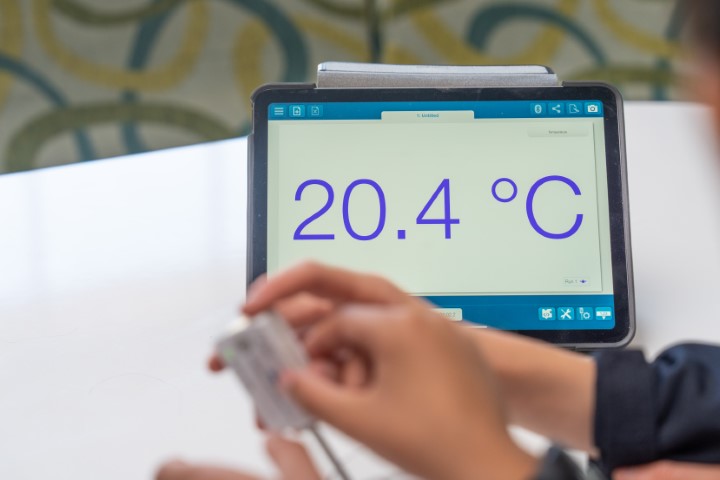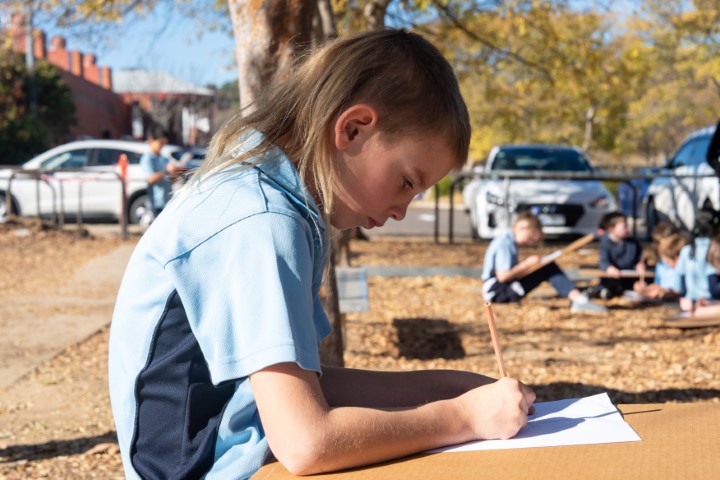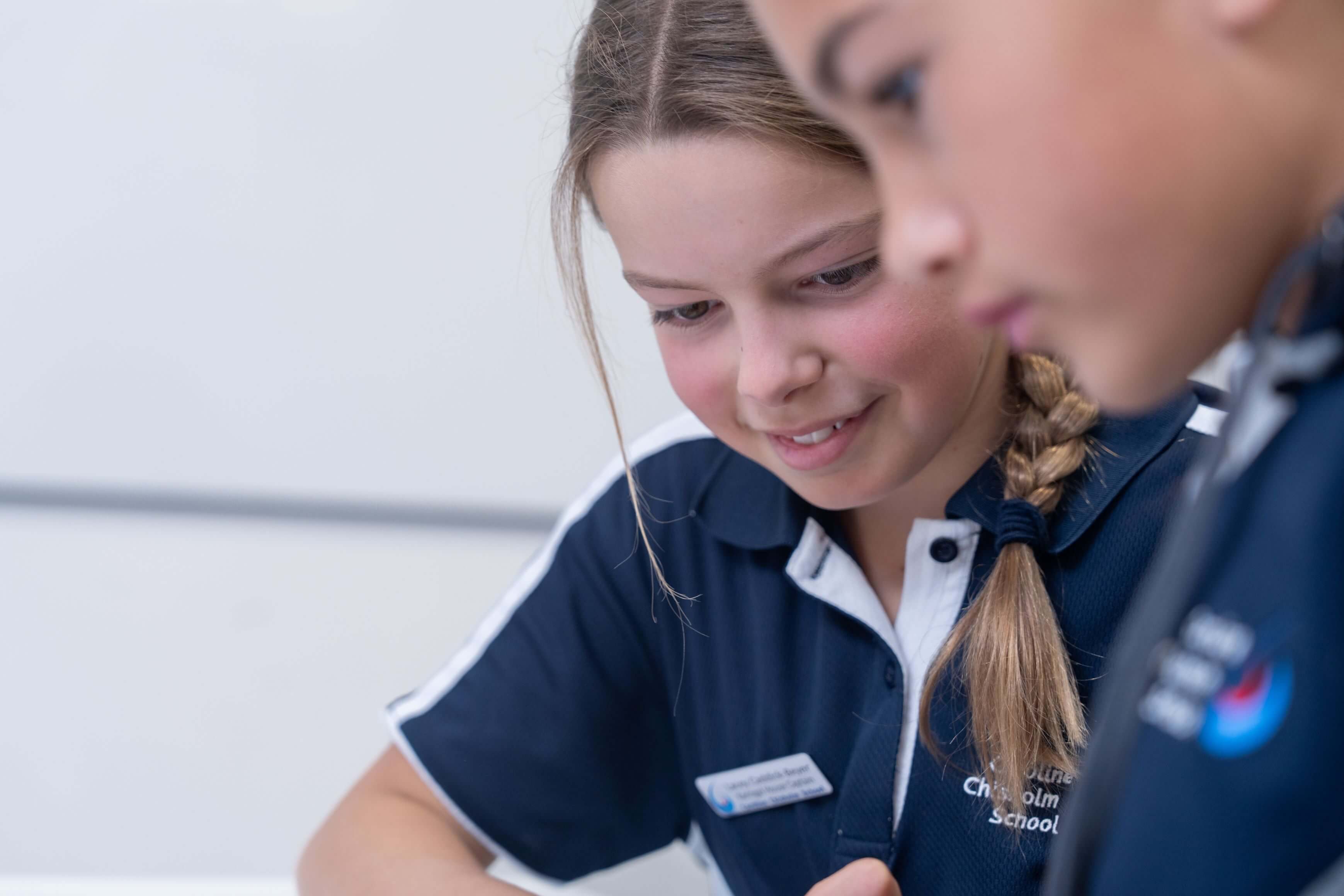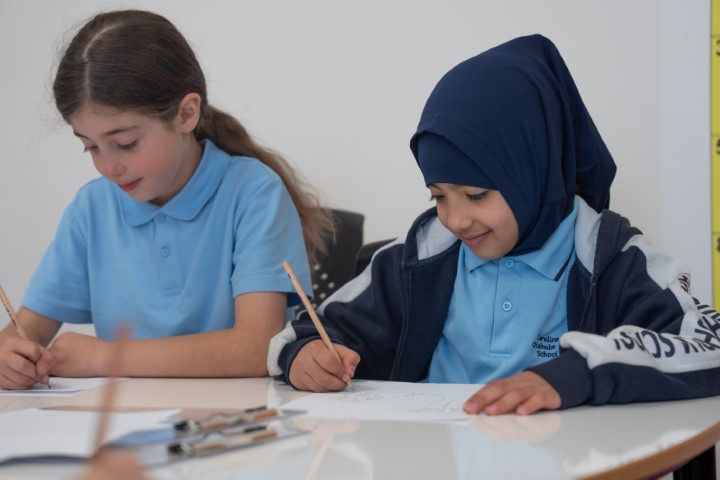Scorching swings and slides
View Sequence overviewStudents will:
- identify heat sources.
- categorise objects as being a source of heat themselves, or as being warmed by something else.
- use data tables to identify relationships and patterns between objects that release heat (heat sources).
Students will represent their understanding as they:
- contribute to the joint construction of data tables.
- use oral, written and visual language to record and discuss their observations of heat sources.
- engage in discussion to compare ideas about heat sources.
In this lesson, assessment is formative.
Feedback might focus on:
- Have students correctly identified objects that release heat (heat sources), and those that do not?
- Are students reasoning and making justifications based on the evidence they have collected?
- Can students identify similarities between objects that release heat?
Whole class
Class science journal (hard-copy or digital)
Demonstration copy of What's hot Resource sheet (or create your own)
Candle and a means to light it
Hot water bottle, and warm water to fill it
Each student
Individual science journal (hard-copy or digital)
What's hot Resource sheet (or create their own)
Safety notes
Candles: Extreme caution must be taken when using lit candles in a classroom. Consider setting up an exclusion zone to ensure students do not come too close to the lit candle. Under no circumstances should students touch the flame of the candle. The heat of the candle will be most noticeable above the flame rather than beside the flame. Special care should be taken above the flame.
Hot water: Any hot water used in a classroom should be at or below 43°C. Any hot water bottle/heat pack etc. should never be opened or pierced with a sharp object. They should always be covered with a layer of insulating material and should never be placed directly onto the body—particularly with children, who may have a reduced sensation to heat.
Lesson
The Inquire phase allows students to cycle progressively and with increasing complexity through the key science ideas related to the core concepts. Each Inquire cycle is divided into three teaching and learning routines that allow students to systematically build their knowledge and skills in science and incorporate this into their current understanding of the world.
When designing a teaching sequence, it is important to consider the knowledge and skills that students will need in the final Act phase. Consider what the students already know and identify the steps that need to be taken to reach the level required. How could you facilitate students’ understanding at each step? What investigations could be designed to build the skills at each step?
Read more about using the LIA FrameworkRe-orient
Recall the previous lesson, focusing on the discussion of the source of the heat on a sunny day, and the objects students named that get warm/hot in the sun.
If not already done so in Lesson 1, remind students that they will be learning about heat, how it moves, and its impact on playgrounds and their equipment, and how we can stop them from getting too hot. Brainstorm a list of student questions on this.
Heat energy
Heat is a form of energy, and energy (in any form, including heat) can be neither created nor destroyed.

Heat is a form of energy. While we use the term ‘make heat’ here, energy (in any form, including heat) can be neither created nor destroyed, but rather is transferred or transformed. The Australian Curriculum dictates that at this year level students explore energy (in the form of heat) transfer.
At this stage it is acceptable to use everyday language such as ‘making their own heat’ to describe objects that transform one type of energy into another, such as a hairdryer converting electrical energy into heat, or a candle transforming stored chemical energy into light/heat.
Heat is a form of energy. While we use the term ‘make heat’ here, energy (in any form, including heat) can be neither created nor destroyed, but rather is transferred or transformed. The Australian Curriculum dictates that at this year level students explore energy (in the form of heat) transfer.
At this stage it is acceptable to use everyday language such as ‘making their own heat’ to describe objects that transform one type of energy into another, such as a hairdryer converting electrical energy into heat, or a candle transforming stored chemical energy into light/heat.
The Inquire phase allows students to cycle progressively and with increasing complexity through the key science ideas related to the core concepts. Each Inquire cycle is divided into three teaching and learning routines that allow students to systematically build their knowledge and skills in science and incorporate this into their current understanding of the world.
When designing a teaching sequence, it is important to consider the knowledge and skills that students will need in the final Act phase. Consider what the students already know and identify the steps that need to be taken to reach the level required. How could you facilitate students’ understanding at each step? What investigations could be designed to build the skills at each step?
Read more about using the LIA FrameworkIdentifying and constructing questions is the creative driver of the inquiry process. It allows students to explore what they know and how they know it. During the Inquire phase of the LIA Framework, the Question routine allows for past activities to be reviewed and to set the scene for the investigation that students will undertake. The use of effective questioning techniques can influence students’ view and interpretation of upcoming content, open them to exploration and link to their current interests and science capital.
When designing a teaching sequence, it is important to spend some time considering the mindset of students at the start of each Inquire phase. What do you want students to be thinking about, what do they already know and what is the best way for them to approach the task? What might tap into their curiosity?
Read more about using the LIA FrameworkWhat objects are hot?
Refer back to the list of student questions about playgrounds and heat. Draw on a student question (if one has been asked) as a jumping off point for the following investigation about objects that release heat. For example, What things are hot?
If students haven’t asked a question like this themselves, add it to the list of class questions and discuss how answering this question will be the centre of today’s investigation.
The Inquire phase allows students to cycle progressively and with increasing complexity through the key science ideas related to the core concepts. Each Inquire cycle is divided into three teaching and learning routines that allow students to systematically build their knowledge and skills in science and incorporate this into their current understanding of the world.
When designing a teaching sequence, it is important to consider the knowledge and skills that students will need in the final Act phase. Consider what the students already know and identify the steps that need to be taken to reach the level required. How could you facilitate students’ understanding at each step? What investigations could be designed to build the skills at each step?
Read more about using the LIA FrameworkThe Investigate routine provides students with an opportunity to explore the key ideas of science, to plan and conduct an investigation, and to gather and record data. The investigations are designed to systematically develop content knowledge and skills through increasingly complex processes of structured inquiry, guided inquiry and open inquiry approaches. Students are encouraged to process data to identify trends and patterns and link them to the real-world context of the teaching sequence.
When designing a teaching sequence, consider the diagnostic assessment (Launch phase) that identified the alternative conceptions that students held. Are there activities that challenge these ideas and provide openings for discussion? What content knowledge and skills do students need to be able to complete the final (Act phase) task? How could you systematically build these through the investigation routines? Are there opportunities to build students’ understanding and skills in the science inquiry processes through the successive investigations?
Read more about using the LIA FrameworkAsking questions about heat
Using one or both of the demonstrations described below, explore how some objects, such as a candle, can ‘make their own heat’, whilst others, such as a hot water bottle, only feel warm when they are heated by another source.
Discuss how to safely identify if objects are warm or hot to the touch: by moving your hand slowly towards the object, your hand can be quickly withdrawn as soon as you feel it becoming hot.
Model how to record information during the investigation using the What's hot Resource sheet that students will use later in the lesson.

Allow students to touch, observe and discuss an unlit candle.
- Did you expect it to be hot? Why/Why not?
- What does it need in order to be hot? Why?
Light the candle and determine how hot it is, and if it is a source of heat.
- Where is the heat coming from? The candle or the flame?
- The heat is coming from the flame/burning wax.
- How do you know?
- We can see it burning. The base of the candle is not hot.
Allow students to touch, observe and discuss the empty hot water bottle.
- What is this and what it is used for?
- What does it need in order to be hot? Why?
Fill the hot water bottle with warm water and close it tightly.
Allow students to feel it again and discuss what has changed.
- Is the hot water bottle the source of the heat, or is it heated by something else?
- The hot water bottle is heated by something else.
- How do you know?
- The hot water is heating the bottle. The water was heated before it was poured into the bottle.
Students draw a diagram to represent where the heat was moving from and to in the demonstrations. Organise a gallery walk so that students can discuss the features in the diagrams that best demonstrate heat transfer, and draw their attention to the diagrams that have used arrows.
Discuss why arrows are a clear way of showing the movement of heat: they show clearly where the heat is coming from, the direction it’s moving in, and what objects it might be heating.
- Which diagrams showed the movement of heat the most clearly?
- Why do you think that?
- Why do you think arrows can be helpful to show the movement of heat?
- What other movements could we represent with arrows?
- What about different sized arrows? Long ones vs short ones, or thick ones vs thin ones—what might they represent?
Developing a representational language in context
Use students’ existing literacy skills to draw out the scientific convention for representing heat transfer in context.

Asking students to draw a diagram showing the movement of heat challenges them to use their existing literacy skills to show what they think was happening during the demonstrations.
The standard scientific convention is to use arrows to show the direction and magnitude of energy transfer. Although it is unlikely students will specifically know to use this convention, it is very likely that many will naturally use arrows to show, for example, the heat moving from the candle to the air, or from the water to the hot water bottle.
By monitoring what students are drawing, the teacher can draw attention to specific diagrams that use arrows during the gallery walk. Highlighting how arrows are helpful for showing the movement of heat from a heat source to another object or place establishes this standard scientific convention in a relevant context for students.
Asking students to draw a diagram showing the movement of heat challenges them to use their existing literacy skills to show what they think was happening during the demonstrations.
The standard scientific convention is to use arrows to show the direction and magnitude of energy transfer. Although it is unlikely students will specifically know to use this convention, it is very likely that many will naturally use arrows to show, for example, the heat moving from the candle to the air, or from the water to the hot water bottle.
By monitoring what students are drawing, the teacher can draw attention to specific diagrams that use arrows during the gallery walk. Highlighting how arrows are helpful for showing the movement of heat from a heat source to another object or place establishes this standard scientific convention in a relevant context for students.
Gallery walk
In a gallery walk, students move about the room examining the work of their peers.

In a gallery walk, students move about the room examining the work of their peers. They might discuss what they see with a partner, or use post-it notes to post comments and questions about what they are seeing. Class discussion and careful questioning can then be used to draw attention to specific aspects.
In this instance you would draw attention to the use of arrows to show the movement of heat, establishing this standard scientific convention in a relevant context for students.
In a gallery walk, students move about the room examining the work of their peers. They might discuss what they see with a partner, or use post-it notes to post comments and questions about what they are seeing. Class discussion and careful questioning can then be used to draw attention to specific aspects.
In this instance you would draw attention to the use of arrows to show the movement of heat, establishing this standard scientific convention in a relevant context for students.
The Inquire phase allows students to cycle progressively and with increasing complexity through the key science ideas related to the core concepts. Each Inquire cycle is divided into three teaching and learning routines that allow students to systematically build their knowledge and skills in science and incorporate this into their current understanding of the world.
When designing a teaching sequence, it is important to consider the knowledge and skills that students will need in the final Act phase. Consider what the students already know and identify the steps that need to be taken to reach the level required. How could you facilitate students’ understanding at each step? What investigations could be designed to build the skills at each step?
Read more about using the LIA FrameworkThe Investigate routine provides students with an opportunity to explore the key ideas of science, to plan and conduct an investigation, and to gather and record data. The investigations are designed to systematically develop content knowledge and skills through increasingly complex processes of structured inquiry, guided inquiry and open inquiry approaches. Students are encouraged to process data to identify trends and patterns and link them to the real-world context of the teaching sequence.
When designing a teaching sequence, consider the diagnostic assessment (Launch phase) that identified the alternative conceptions that students held. Are there activities that challenge these ideas and provide openings for discussion? What content knowledge and skills do students need to be able to complete the final (Act phase) task? How could you systematically build these through the investigation routines? Are there opportunities to build students’ understanding and skills in the science inquiry processes through the successive investigations?
Read more about using the LIA FrameworkRecording data on what’s hot
Students work in collaborative learning teams to list objects that might release heat, recording the information on their What's hot Resource sheet. They then feel these objects and decide if they feel ‘normal’ (i.e. are not releasing heat), warm or hot. Encourage them to explore the classroom and the school grounds. They might also list items at home and add the results of their investigation to the data table at a later stage.
Care should be taken when touching objects to avoid burns. You might also like to ask students to note what part of an object felt warm, or if it felt the same temperature all over. For example, a laptop screen may feel slightly warm to the touch, but underneath closer to the battery may feel warmer.
Collaboration
Working collaboratively benefits students in a multitude of ways.

Students engaged in collaborative learning observe and consider multiple perspectives, take on different roles in investigations, and contribute to rich evidence-based discussions. They are able to discuss, compare and build on one another's ideas, revise and rethink their reasoning and contribute to the creation of multi-model representations.
The Australian Council for Educational Research (ACER) reiterates that providing opportunities for students to work collaboratively can lead to enhance cognitive development, encourages more explicit articulation when asking questions and sharing ideas, enables students to practice justifying their reasoning, and increases student reflection and awareness of learning.
Developing effective collaboration skills requires time, opportunity, modelling and support.
Students engaged in collaborative learning observe and consider multiple perspectives, take on different roles in investigations, and contribute to rich evidence-based discussions. They are able to discuss, compare and build on one another's ideas, revise and rethink their reasoning and contribute to the creation of multi-model representations.
The Australian Council for Educational Research (ACER) reiterates that providing opportunities for students to work collaboratively can lead to enhance cognitive development, encourages more explicit articulation when asking questions and sharing ideas, enables students to practice justifying their reasoning, and increases student reflection and awareness of learning.
Developing effective collaboration skills requires time, opportunity, modelling and support.
The Inquire phase allows students to cycle progressively and with increasing complexity through the key science ideas related to the core concepts. Each Inquire cycle is divided into three teaching and learning routines that allow students to systematically build their knowledge and skills in science and incorporate this into their current understanding of the world.
When designing a teaching sequence, it is important to consider the knowledge and skills that students will need in the final Act phase. Consider what the students already know and identify the steps that need to be taken to reach the level required. How could you facilitate students’ understanding at each step? What investigations could be designed to build the skills at each step?
Read more about using the LIA FrameworkFollowing an investigation, the Integrate routine provides time and space for data to be evaluated and insights to be synthesized. It reveals new insights, consolidates and refines representations, generalises context and broadens students’ perspectives. It allows student thinking to become visible and opens formative feedback opportunities. It may also lead to further questions being asked, allowing the Inquire phase to start again.
When designing a teaching sequence, consider the diagnostic assessment that was undertaken during the Launch phase. Consider if alternative conceptions could be used as a jumping off point to discussions. How could students represent their learning in a way that would support formative feedback opportunities? Could small summative assessment occur at different stages in the teaching sequence?
Read more about using the LIA FrameworkSources of heat
Each team shares the name of an object they have examined that released heat and whether they think it is a heat source, providing a reason for their thinking. As each team shares their object, it is added to the appropriate column of a modified T-chart in the class science journal. Check to see if other teams agree and why or why not.
Sample student responses
| Heat source | Not a heat source | How do we know? |
| Hairdryer | The hairdryer only gets hot when you turn it on. There are metal bits inside that get hot when it’s turned on. | |
| Playground surface | The playground doesn’t have any way of making heat by itself—there’s no motor or heater. It is not plugged in. It gets its heat from the sun. On a cloudy day it is not hot. |
- What other heat sources can you think of?
- What might you say about the objects that make their own heat? What is similar about them? Different?
- What might you say about the objects that are heated by something else? What is similar about them? Different?
Reflect on the lesson
You might:
- review the list of questions in the class science journal. Determine which questions have been answered during the session and add any new questions that have arisen.
- reflect on how this learning is relevant to learning about the impact of heat on a playground.
- What are the sources of heat in a playground?
- Do these things make their own heat, or are they heated by something else?
- What role does the sun play as a source of heat in a playground?
- add to the class word wall of vocabulary related to heat.
- re-examine the intended learning goals for the lesson and consider how they were achieved.
- discuss how students were thinking and working like scientists during the lesson. Focus on how they collaborated to investigate sources of heat, how they recorded their data in tables, and how this made it easier for them to find patterns.
Representation—Modified T-chart
Adding a column titled ‘How do we know?’ to this T-chart supports students to begin expanding on their ideas and link them to evidence.

Adding a column titled ‘How do we know?’ to this T-chart supports students to begin expanding on their ideas and link them to evidence. By articulating, communicating and debating ideas and claims that are supported by the evidence they have collected, students are able to develop a deeper understanding of science and the way scientists think and work. This argumentation is at the heart of what scientists do.
Adding a column titled ‘How do we know?’ to this T-chart supports students to begin expanding on their ideas and link them to evidence. By articulating, communicating and debating ideas and claims that are supported by the evidence they have collected, students are able to develop a deeper understanding of science and the way scientists think and work. This argumentation is at the heart of what scientists do.
Energy transformation
Some students may offer ideas about energy transformation, which is introduced in Year 6.

As is required in Year 3, this sequence focuses on the key idea that energy (in this case heat energy) can be transferred. Students might begin to notice that objects that release heat are typically connected to another energy source such as electricity or batteries. This is an example of the Year 6 concept of energy transformation.
It is not necessary for students to demonstrate an understanding of energy transformation at this year level. If students offer these ideas, they should be accepted and validated by being included in the explanation added to the class science journal. However, making energy transformation a focus may introduce concepts before students have the prior knowledge required to understand and integrate them. Instead, shift the focus back to how the heat being released is moving (being transferred) from one object/place/material to another.
As is required in Year 3, this sequence focuses on the key idea that energy (in this case heat energy) can be transferred. Students might begin to notice that objects that release heat are typically connected to another energy source such as electricity or batteries. This is an example of the Year 6 concept of energy transformation.
It is not necessary for students to demonstrate an understanding of energy transformation at this year level. If students offer these ideas, they should be accepted and validated by being included in the explanation added to the class science journal. However, making energy transformation a focus may introduce concepts before students have the prior knowledge required to understand and integrate them. Instead, shift the focus back to how the heat being released is moving (being transferred) from one object/place/material to another.